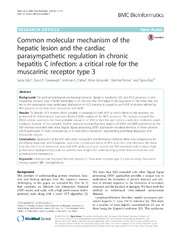Приказ основних података о документу
Common molecular mechanism of the hepatic lesion and the cardiac parasympathetic regulation in chronic hepatitis C infection: a critical role for the muscarinic receptor type 3
| dc.creator | Glišić, Sanja | |
| dc.creator | Cavanaugh, David P. | |
| dc.creator | Chittur, Krishnan K. | |
| dc.creator | Senćanski, Milan V. | |
| dc.creator | Perović, Vladimir R. | |
| dc.creator | Bojić, Tijana | |
| dc.date.accessioned | 2018-03-01T16:45:21Z | |
| dc.date.available | 2018-03-01T16:45:21Z | |
| dc.date.issued | 2016 | |
| dc.identifier.issn | 1471-2105 | |
| dc.identifier.uri | https://vinar.vin.bg.ac.rs/handle/123456789/977 | |
| dc.description.abstract | Background: The pathophysiological overlapping between Sjorgens Syndrome (SS) and HCV, presence of anti-muscarinic receptor type 3 (M3R) antibodies in SS, the role that M3R plays in the regulation of the heart rate, has led to the assumption that cardiovagal dysfunction in HCV patients is caused by anti-M3R antibodies elicited by HCV proteins or by their direct interaction with M3R. Results: To identify HCV protein which possibly is crossreactive with M3R or which binds to this receptor, we performed the Informational Spectrum Method (ISM) analysis of the HCV proteome. This analysis revealed that NS5A protein represents the most probable interactor of M3R or that this viral protein could elicit antibodies which modulate function of this receptor. Further detailed structure/function analysis of NS5A and M3R performed by the ISM method extended with other Digital Signal processing (DSP) approaches revealed domains of these proteins which participate in their crossreactivity or in their direct interaction, representing promising diagnostic and therapeutic targets. Conclusions: Application of the ISM with other compatible bioinformatics methods offers new perspectives for identifying diagnostic and therapeutic targets for complicated forms of HCV and other viral infections. We show how the electron-ion interaction potential (EIIP) amino-acid scale used in the ISM combined with a robust, high performance hydrophobicity scale can provide new insights for understanding protein structure/function and protein-protein interactions. | en |
| dc.relation | info:eu-repo/grantAgreement/MESTD/Integrated and Interdisciplinary Research (IIR or III)/41028/RS// | |
| dc.relation | info:eu-repo/grantAgreement/MESTD/Basic Research (BR or ON)/173001/RS// | |
| dc.rights | openAccess | en |
| dc.rights.uri | https://creativecommons.org/licenses/by/4.0/ | |
| dc.source | BMC Bioinformatics | en |
| dc.subject | Informational Spectrum Method | en |
| dc.subject | Hepatitis C | en |
| dc.subject | Muscarinic receptor type 3 | en |
| dc.subject | Cross-reactivity | en |
| dc.subject | Autonomic nervous system | en |
| dc.subject | EIIP | en |
| dc.subject | Hydrophobicity | en |
| dc.title | Common molecular mechanism of the hepatic lesion and the cardiac parasympathetic regulation in chronic hepatitis C infection: a critical role for the muscarinic receptor type 3 | en |
| dc.type | article | en |
| dc.rights.license | BY | |
| dcterms.abstract | Цхиттур, Крисхнан К.; Глишић Сања; Цаванаугх, Давид П.; Сенчански Милан В.; Перовић Владимир; Бојић Тијана; | |
| dc.date.updated | 2020-12-17T14:35:45Z | |
| dc.citation.volume | 17 | |
| dc.citation.spage | 139 | |
| dc.identifier.wos | 000372487900004 | |
| dc.identifier.doi | 10.1186/s12859-016-0988-7 | |
| dc.citation.other | Article Number: 139 | |
| dc.citation.rank | M21 | |
| dc.identifier.pmid | 27000565 | |
| dc.type.version | publishedVersion | |
| dc.identifier.scopus | 2-s2.0-84962449659 | |
| dc.identifier.fulltext | https://vinar.vin.bg.ac.rs//bitstream/id/14351/973.pdf |

